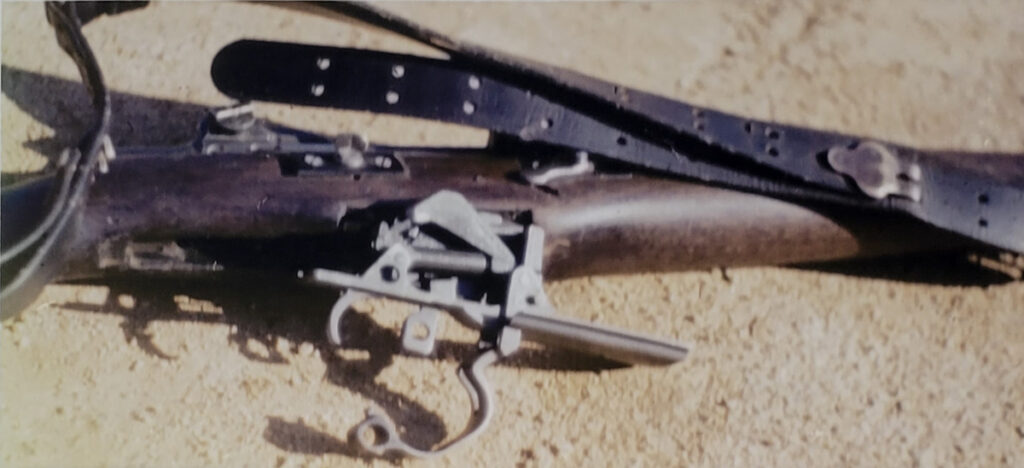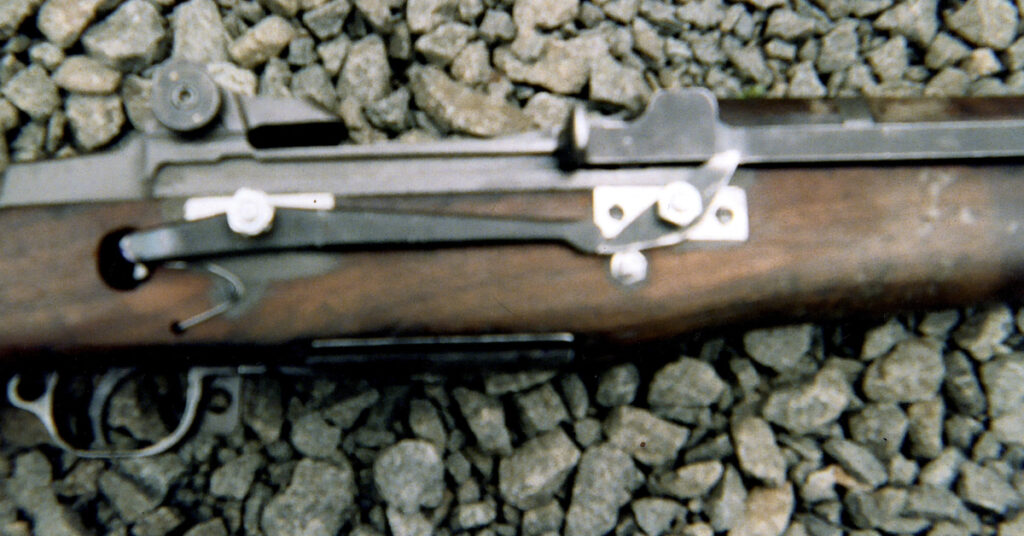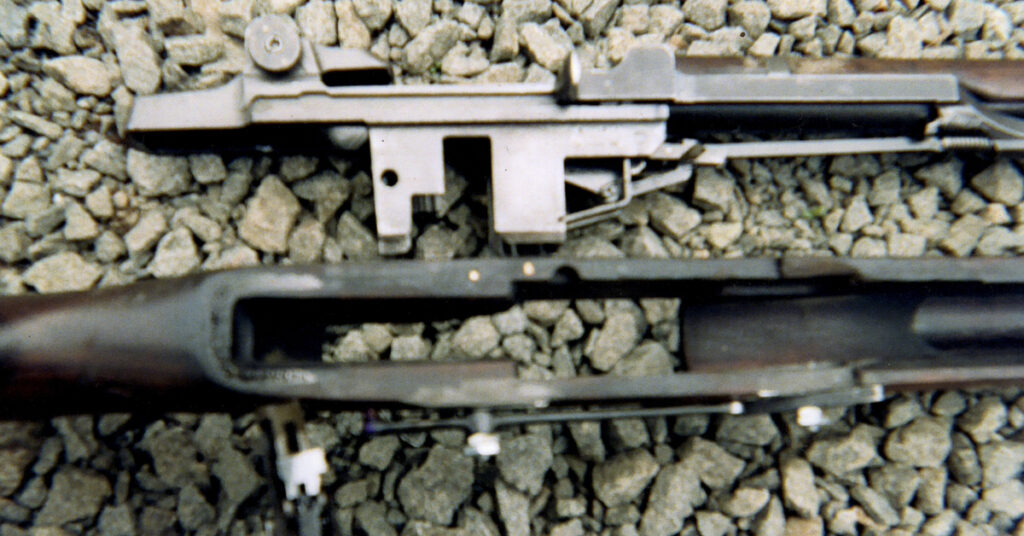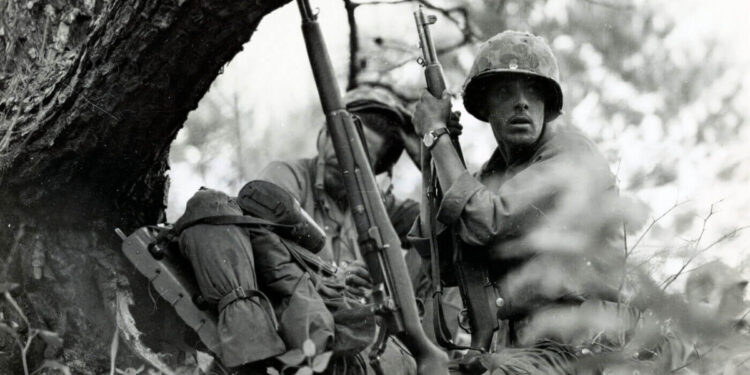By Tom Ring
Thanks to the ingenuity of one man, a Marine infantry unit serving in the Korean War was equipped with M1 Garand rifles capable of full-auto fire. This is the story of selective fire Garands built by then Marine Staff Sergeant Harold Johnson that were used in combat during the Korean War.
During the Korean War, WWII Marine combat veteran Harold Johnson, at the time a staff sergeant, was serving as platoon sergeant in 1st Battalion, 5th Marine Regiment. During his time there, the Korean Army was largely out of the fight, and the enemy were the Chinese communists. The war was fairly static, and his unit spent the bulk of their time in an established bunker and trench line. There were frequent Marine night patrols forward of their line to keep themselves informed of enemy troop activities. Most of the Chinese troops in his area were armed with the Soviet PPSH submachine gun. Naturally most of Hals Marines were armed with the M1 Garand or M1 Carbine with approximately one Thompson submachine gun and one Browning Automatic rifle per squad. In short, he felt that his patrols were short of firepower when they engaged in skirmishes with the Chinese during patrols.

Accordingly, Hal Johnson modified several Garands, though the total number is unknown, to be capable of selective fire. He did this work in the field, which is testimony to his skill. Also bear in mind that Hal Johnson was a tanker in WWII, and an infantryman after that; it was not until after the Korean War that he moved into the Ordnance Corps.
During our many conversations, Hal stated to me that he always sent at least two of his modified rifles out with each patrol. In use, the modified rifles provided good, reliable service. They put lots of rounds in the direction of the enemy and helped keep their heads down. On occasion the front hand guard would char or even smoke from the overheated barrel. A story Hal liked to tell was of a buddy of his from WWII arriving at his unit. This guy’s attitude was “a Springfield was good enough to shoot Japanese, its good enough to shoot Chinese.” Accordingly, he carried a Springfield on his first night patrol, made contact with the enemy and heard burp-gun fire all around him. Upon his return to friendly lines, he promptly asked Hal for one of his modified Garands.

HOW WAS THE RIFLE MODIFIED
The modification made by Johnson was simple in design and was reliable. Starting with the trigger group and working forward, the left disconnector hook is ground off of the hammer to prevent that left hook from engaging. A trip lever is fabricated and installed inside a channel cut inside the stock. This trip lever has a lug welded to its rear that protrudes into the action of the gun. This lug engages with the right side of the disconnector. This trip lever pivots on the selector switch to the rear of the center of the trip lever. A spring is installed under the rear of this trip lever to provide upward tension. A transfer bar is fabricated and installed on the outside of the stock below the charging handle. It pivots at its center and has no spring tension on it. The charging handle is ground flat on its front surface. The transfer bar and trip lever were fabricated from M1919 and M2 .50 caliber feed cover belt feed levers. Disclaimer: This is not a how-to guide on building your own full auto M1. Do not modify an M1 to fire full auto unless you are in possession of the appropriate licenses.

HOW THE RIFLE WORKS, THE CYCLE OF OPERATION
When the rifle is fired, the operating rod moves to the rear, bringing the bolt with it. At the beginning of this movement, the flat surface of the charging handle moves away from the transfer bar. Spring tension on the rear of the trip lever moves it up out of engagement with the right side of the disconnector. toward the end of the rearward travel of the bolt, the hammer will lock in the rearward position, held by the disconnector on the remaining right lug on the hammer. As the bolt is returning forward, and just as the bolt locks up, the flat cut into the front of the charging handle impacts the top of the transfer bar forcing the rear of this transfer bar up. This forces the front of the rear trip lever up, moving the rear of the trip lever down against spring tension. The lug welded to the rear of the trip lever pushes down on the right hook on the disconnector, pushing and holding it to the rear and releasing the hammer to fire the chambered round and firing the successive round. The cycle repeats as long as the trigger is held down, or until the rifle runs out of ammunition.

A MODERN REPRODUCTION OF HAL JOHNSONS DESIGN, PROOF OF CONCEPT
Some years ago, in the post-1986 era, but prior to the advent of handheld movie studios, hence the low-quality photos taken with a disposable camera, a working copy of Hals design was built. It was built under my tutelage by a tax stamp holder. That individual has long since surrendered his tax stamp and the rifle was duly turned into the BATFE. I like to think that it resides in their reference collection. It was built as a tool-room prototype with no attempt to make it pretty or field worthy. It also lacks the selective fire option and is full-auto only. This rifle ran and ran flawlessly for many rounds. The rate of fire was an estimated 600 rounds per minute. Controllability of this rifle was not great, but it was manageable for an experienced full-auto shooter. As the owner of an original M-14, I can state that it was more controllable than an M-14 in full-auto mode. It is worth noting that it is possible to build this design to operate at a rate of fire of 600 per minute up to 800 rounds per minute. To do this imagine the lock-up of the bolt and auto firing taking place during a very short window of time. If the rifle fires at the earliest moment in this window, the rate of fire will be faster. The reproduction rifle I fired could have been made to shoot at a higher RPM by adding metal to any contact surface in the linkage, causing a slightly earlier release of the hammer by the lug on the rear of the trip lever.

Though largely unknown, Garands capable of full-auto fire were used in combat in the Korean war by infantry Marines in 1/5 courtesy of the efforts of one smart and able man, Harold Johnson, who has gone largely unrecognized by history.












